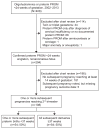Pregnancy Outcomes in Women With a History of Previable, Preterm Prelabor Rupture of Membranes
- PMID: 27741176
- PMCID: PMC5774863
- DOI: 10.1097/AOG.0000000000001682
Pregnancy Outcomes in Women With a History of Previable, Preterm Prelabor Rupture of Membranes
Erratum in
-
Pregnancy Outcomes in Women With a History of Previable, Preterm Prelabor Rupture of Membranes: Correction.Obstet Gynecol. 2017 Jan;129(1):209. doi: 10.1097/AOG.0000000000001845. Obstet Gynecol. 2017. PMID: 28092303 Free PMC article. No abstract available.
Abstract
Objective: To characterize subsequent pregnancy outcomes among women with a history of previable, preterm prelabor rupture of membranes (PROM) and assess factors associated with recurrent preterm birth.
Methods: This was a retrospective cohort study of women cared for with a history of one or more singleton pregnancy complicated by preterm PROM at less than 24 weeks of gestation between 2002 and 2013 who were cared for in two tertiary care health systems by a single group of maternal-fetal medicine specialists. Women were identified using International Classification of Diseases, 9th Revision codes and obstetric databases. Those with iatrogenic preterm PROM and those whose index preterm PROM at less than 24 weeks of gestation was preceded by advanced cervical dilation were excluded. All women with one or more pregnancies reaching the second trimester after an index previable, preterm PROM pregnancy were included. The primary outcome was recurrent preterm birth at less than 37 weeks of gestation. Data were analyzed by χ, Fisher exact, t test, Wilcoxon rank-sum, and logistic regression.
Results: Two hundred ninety-four women had one or more pregnancies complicated by previable, preterm PROM. One hundred eight of 294 (37%) had one or more subsequent pregnancies in our health care systems and 50 of 108 (46%) had two or more. In the pregnancy immediately after the index delivery, the risk of prematurity was high: 50 (46%) delivered at less than 37 weeks of gestation, 31 (30%) at less than 34 weeks of gestation, 25 (23%) at less than 28 weeks of gestation, and 18 (17%) before 24 weeks of gestation. Fewer than half (n=49 [45%]) of women received preterm birth prophylaxis (progesterone or cerclage) in a subsequent pregnancy; rates of recurrent preterm birth were similar among women who received preterm birth prophylaxis compared with those who did not. In regression models, the only factor significantly associated with recurrent preterm birth at less than 37 weeks of gestation was a history of preterm birth preceding previable, preterm PROM delivery (adjusted odds ratio 3.23, 95% confidence interval 1.32-7.93).
Conclusion: Patients with a history of previable, preterm PROM are at high risk of recurrent preterm birth.
Figures
Similar articles
-
The Role of Cerclage in Subsequent Pregnancy following Previable Prelabor Rupture of Membranes.Am J Perinatol. 2024 May;41(S 01):e1397-e1403. doi: 10.1055/a-2028-7633. Epub 2023 Feb 6. Am J Perinatol. 2024. PMID: 36746399
-
Maternal, perinatal and childhood outcomes of the PPROMEXIL-III cohort: Pregnancies complicated by previable prelabor rupture of membranes.Eur J Obstet Gynecol Reprod Biol. 2021 Oct;265:44-53. doi: 10.1016/j.ejogrb.2021.08.007. Epub 2021 Aug 8. Eur J Obstet Gynecol Reprod Biol. 2021. PMID: 34428686
-
Outcomes of Pregnancies Complicated by Preterm Premature Rupture of Membranes Between 20 and 24 Weeks of Gestation.Obstet Gynecol. 2016 Aug;128(2):313-320. doi: 10.1097/AOG.0000000000001530. Obstet Gynecol. 2016. PMID: 27400016
-
Progestogens in singleton gestations with preterm prelabor rupture of membranes: a systematic review and metaanalysis of randomized controlled trials.Am J Obstet Gynecol. 2018 Oct;219(4):346-355.e2. doi: 10.1016/j.ajog.2018.03.027. Epub 2018 Mar 31. Am J Obstet Gynecol. 2018. PMID: 29614278
-
[Prevention of spontaneous preterm birth (excluding preterm premature rupture of membranes): Guidelines for clinical practice - Text of the Guidelines (short text)].J Gynecol Obstet Biol Reprod (Paris). 2016 Dec;45(10):1446-1456. doi: 10.1016/j.jgyn.2016.09.011. Epub 2016 Nov 9. J Gynecol Obstet Biol Reprod (Paris). 2016. PMID: 27836377 Review. French.
Cited by
-
Pregnancy Outcomes in Women With a History of Previable, Preterm Prelabor Rupture of Membranes: Correction.Obstet Gynecol. 2017 Jan;129(1):209. doi: 10.1097/AOG.0000000000001845. Obstet Gynecol. 2017. PMID: 28092303 Free PMC article. No abstract available.
References
-
- Lee T, Silver H. Etiology and epidemiology of preterm premature rupture of the membranes. Clin Perinatol. 2001;28(4):721–34. - PubMed
-
- Yeast JD. Preterm premature rupture of the membranes before viability. Clin Perinatol. 2001;28(4):849–60. - PubMed
-
- Manuck TA, Eller AG, Esplin MS, Stoddard GJ, Varner MW, Silver RM. Outcomes of expectantly managed preterm premature rupture of membranes occurring before 24 weeks of gestation. Obstet Gynecol. 2009;114(1):29–37. - PubMed
Publication types
MeSH terms
Grants and funding
LinkOut - more resources
Full Text Sources
Other Literature Sources



